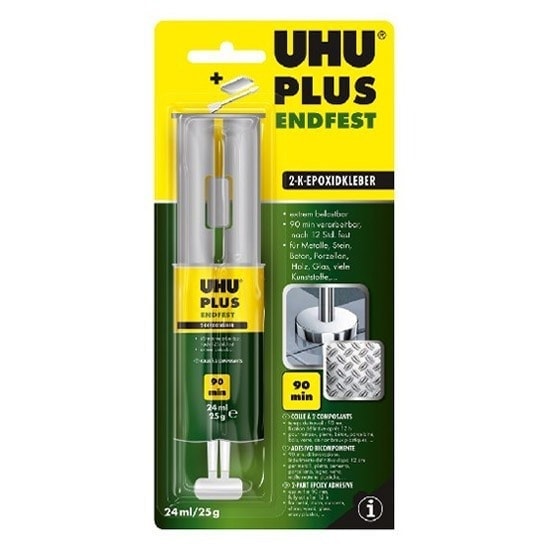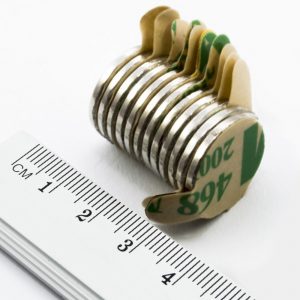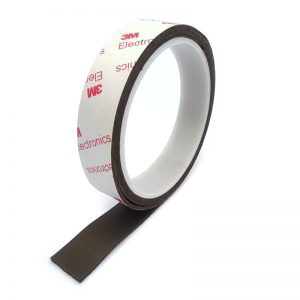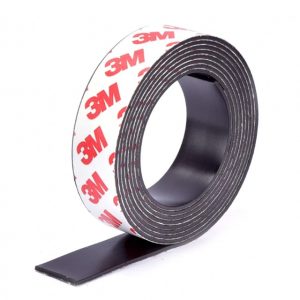Glue UHU PLUS ENDFEST 300 24 ml
11,99€ inc. Vat
Two-component epoxy glue with a strength of up to 300 kg/cm2.
Properties
| Max. strength | 300 kg/cm2 |
|---|---|
| Glue volume | 2 x 24ml |
| Temperature resistance | -40 to 100 °C |
| Glue weight | 25 g |
Product description
UHU PLUS ENDFEST 300 is ideal for bonding magnets to various surfaces: metal, wood, chipboard, thermosets, hard PVC, laminates, ceramics, porcelain, glass, concrete, stone, marble, rubber, polystyrene and more.
If you glue two neodymium magnets together, they start to behave just like one big magnet. Using epoxy glue, you can therefore create magnets with dimensions that you might not otherwise find anywhere.
The glue is resistant to moisture, oils, alcohols, solvents, acidic environments (but not concentrated acids). The dried glue can be drilled into or rubbed off without damaging the joint.
UHU PLUS ENDFEST 300 is not suitable for bonding polypropylene (PP), polyethylene (PE), Teflon and silicone.
Instructions for use:
- Clean the surface of dirt and grease. If the surface is damp, wipe it off.
- Remove the cap of the twin injector.
- Squeeze out both the glue and the hardener and mix them in a 1:1 ratio. Stir well.
- Apply the glue to one surface and apply to the other surface. For rough or porous materials, apply the glue to both surfaces.
- Press the surfaces together and fix.
- Clean the ends of the applicator thoroughly. Remove the cap from the plungers and close the applicator.
Store the glue in a dry and cool environment.
The glue can be handled at room temperature for 90 minutes. It reaches its maximum hardness after 12 hours. A temperature of at least 15 °C is required during glue application. At higher temperatures, the hardening rate is greater and the joint also becomes stronger:
| Temperature | Curing time | Strength |
| 20 °C | 12 hours | 120 kg/cm2 |
| 40 °C | 3 hours | 150 kg/cm2 |
| 70 °C | 45 minutes | 200 kg/cm2 |
| 100 °C | 10 minutes | 250 kg/cm2 |
| 180 °C | 5 minutes | 300 kg/cm2 |
When bonding magnets, we do not recommend heating the environment. Although the strength of the joint is increased, the magnets may lose some of their magnetic strength due to the high temperature. The loss of magnetism usually occurs already at 80 °C. The strength of 120 kg is considerably more than the breakaway force of neodymium magnets with a surface area of 1 cm2, so when bonding magnets, the strength of 120 kg/cm2 is usually quite sufficient.
Once dry, the glue can withstand low temperatures down to -20 °C and high temperatures up to 100 °C, which is higher than the normal temperature resistance of neodymium magnets.
Tips from SilneMagnety.sk
In addition to the official information from the manufacturer, we have prepared a few more tips for sticking magnets:
- Remove grease with acetone, isopropyl alcohol or other solvent. Ordinary alcohol can also fulfil this purpose. Grease can get on the magnet with a simple fingerprint. Removing grease can have a huge impact on the strength of the joint.
- Roughen the surface of the magnet with sandpaper. You can also make grooves in the magnet with a nail:

- Make sure that there are no magnetic metals or other magnets around the magnet during curing that pull it away from the surface you are bonding the magnet to.
- You can also use the power of the magnet to your advantage: place a metal object or another magnet on the opposite side of the glued object. The magnet will then be strongly attracted to the surface and fixed well until the glue dries.
- Also try our self-adhesive magnets or magnetic mounts with screw hole.
As an alternative to UHU PLUS ENDFEST 300, you can also use UHU MAX REPAIR universal glue to bond the magnets.
Warning
Glue (epoxy resin):
- corrosive, skin irritant (cat.2)
- causes serious eye irritation/damage (cat.2)
- skin sensitisation (cat.1)
- Hazardous to the aquatic environment (cat.2)
Hardener (amines):
- corrosive, skin irritant (cat.1B)
- causes serious eye irritation/damage (cat.1)
- skin sensitisation (cat.1)



